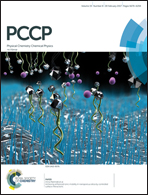The role of π-linkers in tuning the optoelectronic properties of triphenylamine derivatives for solar cell applications – A DFT/TDDFT study†‡
Abstract
A recently reported triphenylamine (TPA) group in conjugation with a benzothiadiazole (BTD) moiety opens up the possibility for designing new organic sensitizers for solar cell applications that are amenable for structural tuning. Hence, seven new TPA molecules were designed from two experimentally reported molecules. The optoelectronic properties, including the absorption and emission spectra of the TPA derivatives, were studied via density functional theory (DFT) and time-dependent density functional theory (TDDFT) methods. Different π-linkers were screened to understand the role of π-linkers in altering the optoelectronic properties of these molecules. Our results show that furan moieties bring planarity to the molecule and show reduced HOMO–LUMO gaps. All these molecules show excellent delocalization of π-electrons. TDDFT calculations show that furan-substituted TPA (TPA9) has the highest absorption maxima. Interestingly, the thiophene-substituted TPA (TPA7) was found to have a high emission maxima as it achieved planarity in the excited state. There is an excellent correlation observed between the computed optoelectronic properties and calculated HOMO–LUMO gaps. Overall, this study throws light on the role of π-linkers in the photophysical properties of TPA derivatives and provides useful clues in designing new molecules for optoelectronic applications.



 Please wait while we load your content...
Please wait while we load your content...